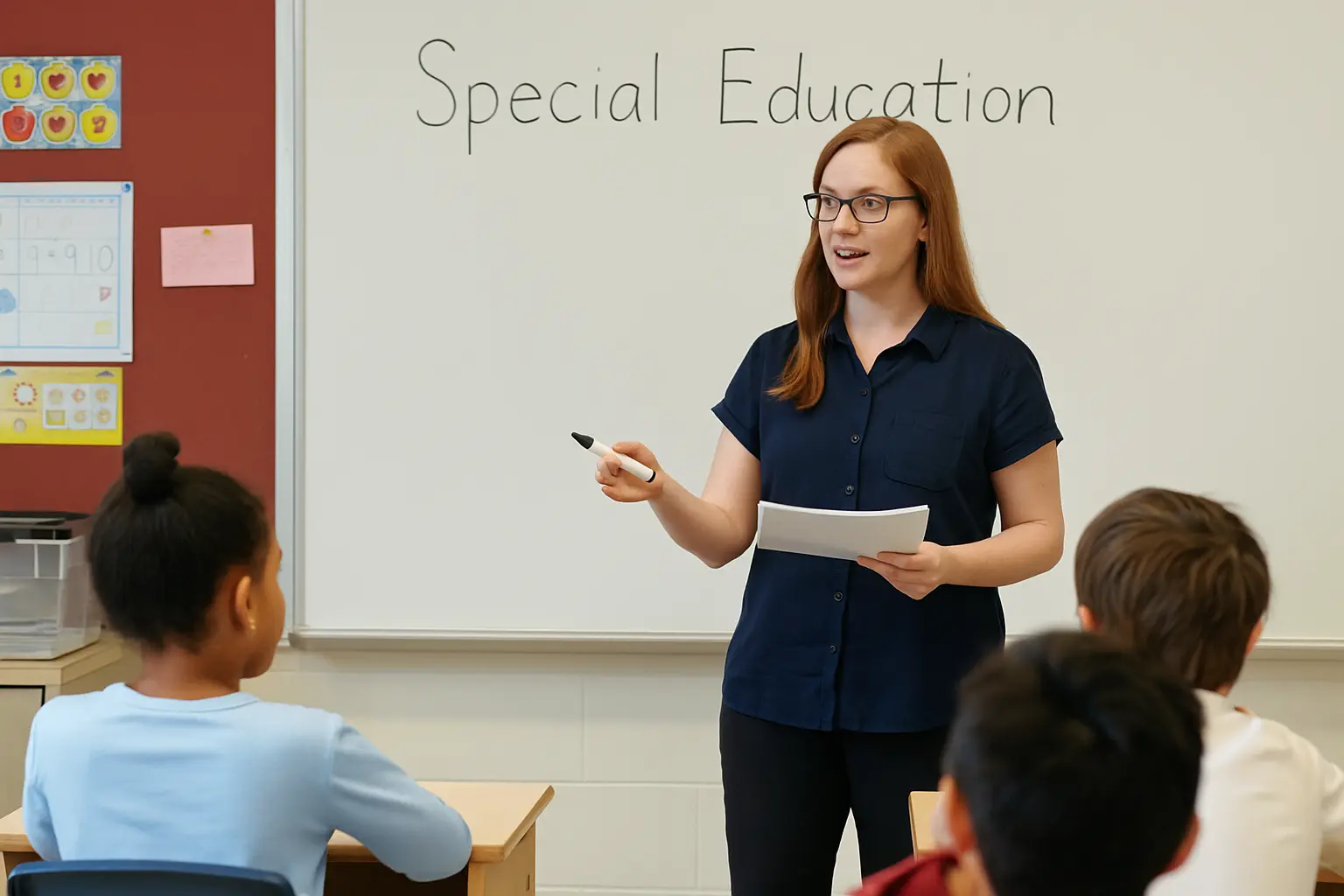Students with disabilities often face added challenges in the classroom, especially when learning disorders affect how they process or retain information. Every diagnosis is different, and because of that, the treatment of disabilities in special education requires teachers to understand a wide range of conditions and strategies.
With the right knowledge, you can better support IEP students, collaborate with other professionals, and create a classroom where learning feels possible for everyone. We have a few pages related to each disorder, and we’ll give more information about each here.

Are Special Education Teachers Required to Treat Disabilities?
Special education teachers aren’t medical professionals, so they’re not required (or even allowed) to diagnose or provide medical treatment for disabilities.
That part is always handled by doctors, psychologists, or other licensed specialists. What teachers are responsible for is supporting students through instruction, accommodations, and classroom strategies outlined in the IEP.
Think of it this way: the treatment plan explains what the student needs, and the teacher focuses on how to make learning accessible. Knowing the basics of treatment helps, but direct medical care is never part of the job.
Treatment Options in Special Education
Teachers aren’t doctors (and shouldn’t try to be), but it’s useful to know what kinds of treatments exist for students with disabilities. That awareness makes it easier to line up your classroom support with what other professionals are doing. In special education, treatment options usually fall into a few main buckets.
First, there are behavioral and academic interventions. These are the day-to-day adjustments you make. For instance, breaking tasks into smaller steps or using visual cues. Sometimes even something as simple as giving extra processing time can completely change how a student engages with a lesson.
Then there’s therapy and related services. You’ll probably work with speech therapists, occupational therapists, or school psychologists at some point. If you know what their role is, you can reinforce those strategies in your own teaching.
Medication is another treatment path, though that’s handled entirely by medical professionals. Your job isn’t to prescribe or suggest, but knowing that a student is on ADHD or anti-anxiety medication can help you understand why their focus or energy levels change throughout the day.
And finally, there’s assistive technology. This part is underrated. A simple text-to-speech tool or an iPad app for organization can open doors for students who otherwise struggle to keep up.

Common Disabilities and Disorders in IEP Students
IEP students represent a wide mix of needs, but some conditions show up more often than others. Autism Spectrum Disorder can affect communication, social skills, or sensory processing. Some kids do well with visual schedules, while others need a quiet space.
ADHD is another common one. Students struggle to sit still or stay focused unless lessons are broken into smaller steps. Dyslexia and other learning disabilities can make reading or math tough, but tools like audiobooks or speech-to-text software help.
Mental health challenges like anxiety and depression also play a role, even if they’re harder to spot. The key is remembering behavior isn’t always “bad”. Unfortunately, it’s often tied to the disability.
Why Treatment Knowledge Matters in Special Education
Special education teachers should have knowledge of different diagnoses and treatments of students with disabilities for several key reasons:
Individualized Instruction
Students with disabilities have unique needs, and understanding their diagnoses helps teachers tailor instruction to meet those needs. Different disabilities, such as autism, ADHD, dyslexia, or learning disabilities, affect students in distinct ways, so a one-size-fits-all approach doesn’t work.
Effective Classroom Management
Knowledge of various diagnoses equips teachers with strategies for managing behavior and creating an inclusive classroom environment. Understanding a student’s challenges, whether sensory, cognitive, or emotional, helps prevent misinterpretation of behaviors and promotes effective strategies for engagement.
Collaboration with Other Professionals
Special education teachers often work as part of a team, including speech therapists, psychologists, and counselors. Having an understanding of the diagnoses allows them to effectively collaborate with these professionals, ensuring that all aspects of the student’s development are addressed.
Fostering Student Growth
Teachers who understand specific diagnoses can implement interventions and support strategies that promote students’ growth, helping them reach their potential. They can also adjust their teaching methods to accommodate different learning styles.
Building Trust with Families
Parents and caregivers are often experts on their child’s condition. When a teacher has a strong understanding of the student’s disability and treatment, it can help foster a positive relationship with families, leading to better communication and a more supportive educational environment.
Legal and Ethical Responsibility
Teachers are required to follow laws like the IDEA (Individuals with Disabilities Education Act), which mandates that students with disabilities receive a free, appropriate education. Understanding diagnoses and treatments ensures they can fulfill these legal requirements and advocate for their students’ rights.
Empathy and Support
Having knowledge of various disabilities helps teachers develop empathy, recognizing the challenges their students face. This understanding also enables them to provide emotional support to students, helping to create a positive, encouraging classroom atmosphere.
In essence, the more informed a special education teacher is about the different diagnoses and treatments, the better equipped they are to provide an environment where students with disabilities can succeed academically, socially, and emotionally.

NASET’s Diagnosis and Treatment Series
NASET has now developed two new series, Diagnosis of Students with Disabilities and Disorders and Treatment Options for Students with Disabilities and Disorders. The latest series on Treatment Options provides teachers professionally based treatment options for a variety of disorders and disabilities involved with students with disabilities.
Further, for children already receiving special education services, teachers may be interested in knowing how the specific disorder or disability is treated (**Note: It is very important to remember that any diagnosis or treatment of a disability or disorder must only be done by a trained and qualified professional or a team of professionals; it is never your role to make a specific diagnosis on any child).
Each article in this series describes the treatment options used to treat a disability or disorder.
LATEST ISSUE of NASET’s Treatment of Disabilities and Disorders for Students Receiving Special Education and Related Services
Treatment of Depression
How is depression treated?
Depression, even the most severe cases, can be treated. The earlier treatment begins, the more effective it is. Depression is usually treated with medication, psychotherapy, or a combination of the two.
Some people may experience treatment-resistant depression, which occurs when a person does not get better after trying at least two antidepressant medications. If treatments like medication and psychotherapy do not reduce depressive symptoms or the need for rapid relief from symptoms is urgent, brain stimulation therapy may be an option to explore.
To Access this article – Click Here

